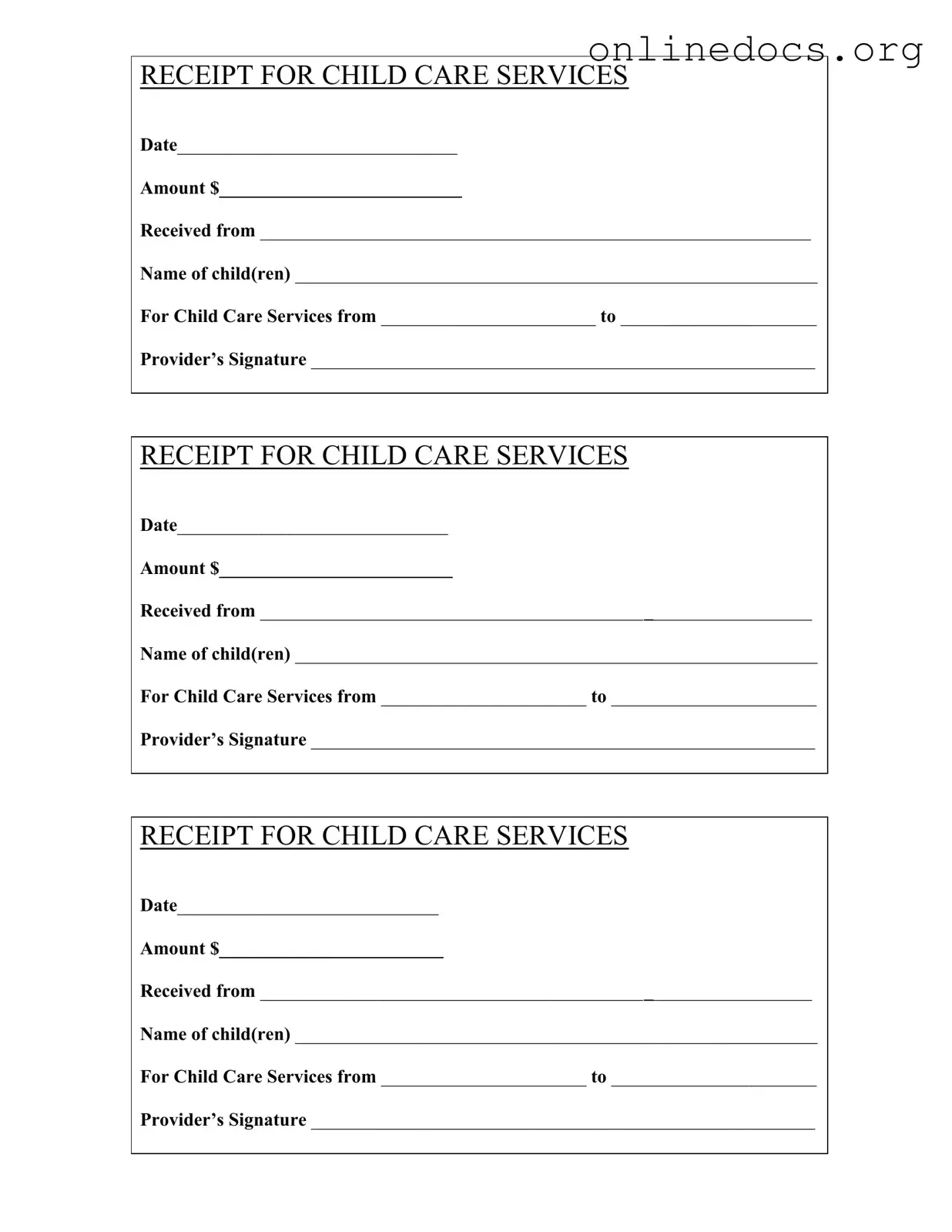The Childcare Receipt form shares similarities with the Tuition Receipt form, which documents payments made for educational services. Like the childcare receipt, it includes essential details such as the date of payment, the amount paid, and the name of the recipient. Both forms serve as proof of payment, allowing parents to keep track of their financial commitments and potentially claim tax deductions related to education or childcare expenses.
Another comparable document is the Medical Receipt form, which is used to record payments for medical services. This form, much like the childcare receipt, includes the date of service, the amount charged, and the patient's name. Both documents provide necessary information for reimbursement claims or tax purposes, ensuring that individuals can substantiate their healthcare expenses accurately.
The Rental Payment Receipt form is also similar, as it records payments made for rental services, whether for residential or commercial properties. This form contains the date, amount, and tenant's name, mirroring the structure of the childcare receipt. Both documents serve as vital evidence of payment, protecting the rights of both the payer and the service provider in case of disputes.
Furthermore, the Invoice Receipt form is akin to the childcare receipt. It details transactions for goods or services rendered, including the date, total amount, and payer's information. Both documents are essential for financial record-keeping, allowing individuals to track their expenses and maintain organized financial records for future reference.
In the realm of rental agreements, understanding the formalities involved is essential, much like in the case of a Childcare Receipt. A vital document in this context is the California Residential Lease Agreement, which helps define the relationship between landlords and tenants. This ensures that the terms of the lease are clear and agreed upon by both parties. To easily access this important form, you can visit californiapdfforms.com/residential-lease-agreement-form where you can fill out the necessary details and ensure a smooth rental process.
The Payment Confirmation form is another document that resembles the childcare receipt. It confirms that a payment has been received, including the date and amount. This form, like the childcare receipt, serves as a record for both parties involved, ensuring clarity and accountability in financial transactions.
Similarly, the Donation Receipt form captures contributions made to charitable organizations. It includes the date, amount donated, and donor's name, paralleling the structure of the childcare receipt. Both documents are crucial for tax purposes, as they provide proof of payment and can be used to claim deductions on tax returns.
The Service Agreement Receipt form also shares characteristics with the childcare receipt. It outlines the terms of service and confirms payment for those services, including the date and amount. Both documents are vital for establishing a clear understanding between the provider and the recipient, ensuring that both parties are aware of their rights and responsibilities.
In addition, the Event Registration Receipt form is similar, as it confirms payment for participation in events or activities. This form includes the date, amount, and registrant's name, much like the childcare receipt. Both documents serve as proof of payment, allowing individuals to keep track of their commitments and participate without confusion.
The Membership Fee Receipt form is another related document, used to acknowledge payments for membership in organizations or clubs. It includes the date, amount, and member's name, paralleling the childcare receipt in its structure. Both forms are important for maintaining accurate records of financial transactions and can be used for tax deductions when applicable.
Lastly, the Subscription Receipt form serves a similar purpose, documenting payments for subscriptions to services or publications. It includes the date, amount, and subscriber's name, mirroring the essential elements found in the childcare receipt. Both documents help individuals manage their finances and provide necessary proof for any potential disputes or tax claims.
